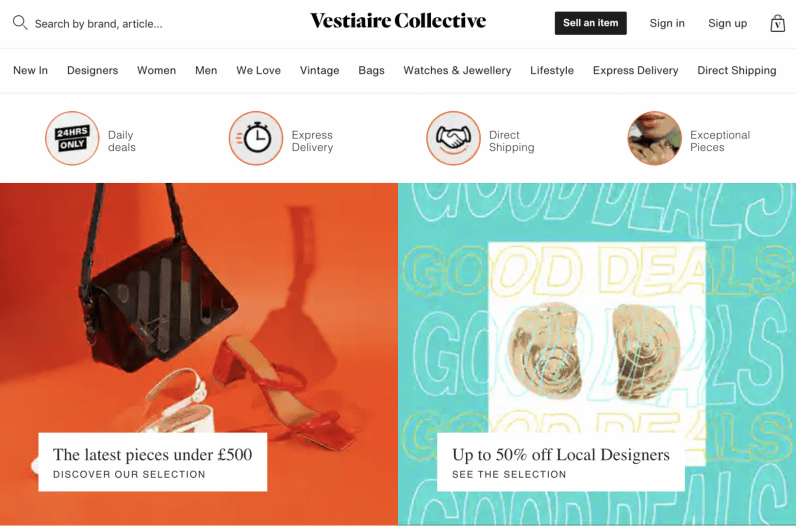
If you’re into luxury fashion, the likelihood is that you’ve already heard of — or even used — Vestiaire Collective.
The brand, first set up in 2009 by co-founders Fanny Moizant and Sophie Hersan, allows fashion enthusiasts to buy and sell pre-owned items online.
Unlike other technology startups and scaleups, Vestiaire Collective’s co-founders don’t hold the CEO role.
This, of course, isn’t unusual as founders often have to hire someone with the relevant experience required to grow their business.
In Vestiaire Collective’s case, the baton was handed over to Max Bittner, formerly the founder and CEO of Lazada Group, in January last year.
[Read: Being a good boss is about being yourself — and a road sweeper]
Although he’s a relative newcomer to the business, Bittner has seemingly found a way to work closely with the founding team without hopefully stepping on each others’ toes:
“Building a close relationship with co-founders was a key priority when I joined the business. We all have different strengths that really complement each other. I lead the business, tech, and commercial team whilst Fanny and Sophie focus on brand and fashion.”
“We don’t agree on everything but we do agree on the important aspects. Making sure you’re aligned on the fundamentals is essential,” he tells Growth Quarters.
Good communication and delegation may well be the secret sauce to business success, and although it’s not always second nature in the boardroom, it must almost always trickle from the top down.
Read on to find out more about the challenges of scaling overseas, what it takes to service a digital native customer base, how to stick to your company’s mission, and the effects of coronavirus on fashion and ecommerce.
Vestiaire Collective: A decade in the making
In just over a decade Vestiaire Collective has grown to employ more than 400 people worldwide.
The company, which has six offices spread out across Europe, the US, and Asia, currently ships to more than 90 countries.

Although Bittner says the company doesn’t publicly disclose financial details, he specifies that it is profitable in France, where it’s headquartered.
To date, Vestiaire Collective has raised €209 million from investors. In April, it announced the closure of a $64.2 million (€59 million) round, drawing participation from new and existing shareholders.
Over 9 million members shop and sell on its platform today, but this growth hasn’t been easy.
“The biggest challenge for the business has predominantly been scaling internationally,” Bittner says. “Each market has its own cultural nuances, meaning you need to dedicate a lot of time to research each market, building a broad understanding of all the factors that can impact your ability to scale successfully,” says the CEO.
[Read: Onfido’s CEO on how to play the fundraising game — stage by stage]
“It’s important to build a strong local team that understands the local nuances and are able to connect the business to the relevant local network,” he continues.
When considering the ‘costs’ of having someone on the ground in a particular market, be aware of the ‘gains’ this brings.
Understanding the nuances of a market, no matter how similar it may seem to your home market, shouldn’t be underestimated if you want to have a serious shot at global expansion.
Millennials and Gen Z: Selling to digital natives
Vestiaire Collective’s target customers are millennials and Gen Z — two digitally-native generations, which he says, also put a lot of emphasis on sustainability.
“It’s really these generations that are disrupting the market and predominantly driving the growth of resale platforms,” he notes.
E-commerce is a particularly challenging space to operate in: Brands need to build a loyal customer base, increase conversion rates, and with almost everyone retailing online, stand out from the crowd.
[Read: Cluno’s co-founder on why her company’s growth keeps her awake at night]
Building — and regaining — trust is also essential, particularly when you’re selling items with a relatively high price point. Customers need to feel comfortable in selling and buyers need to know they are buying an authentic product.
To overcome this, Vestiaire Collective says it has a team of in-house experts who are dedicated to controlling and authenticating every single item.
Quality control is key as it fuels long-term growth. Not only because it ensures that customers are happy but also because it shows the extent to which a company is willing to live by its mission.
How to live your mission
Encouraging a sustainable approach to fashion consumption was a core founding pillar of the company’s model and the CEO says it will remain its key future strategy.
“When the founders launched the platform they spotted a shift in the way people were starting to think about and consume fashion. This evolution has continued to grow over the last 10 years and we believe this will be further escalated by the impact of the current [coronavirus] crisis,” he adds.
“We want to encourage more people to join the circular fashion movement and explore a more sustainable way to enjoy fashion. Leading with an app-first approach, a data centric strategy to improve customer discoverability and engagement, and a strong focus on community will also be key as we work to scale the business further,” Bittner notes.
Vestiaire Collective boasts a sizable following on Instagram — undoubtedly a key component in the success of any consumer-to-consumer brand but also a platform where brands compete in terms of visibility.
Instagram’s algorithm has long been a bone of contention for brands and users and although there are ways to outsmart it, organic growth usually requires perseverance and know-how.
“We try to connect by interacting with our audience in a meaningful way, by asking them what kind of insights and inspiration they want us to share,” Bittner explains.
“We review all the feedback and identify the key pillars our community wants to hear about. Instead of focusing on growing the number of followers, we try our best to deliver content that meets our community’s expectations while providing added value, for example sharing educational insights around sustainability, vintage, and second hand.”
Influencer marketing — although controversial — is an incredibly powerful tool in the fashion and lifestyle industries.
It’s therefore unsurprising that Vestiaire Collective has resorted to this strategy to promote its offering and reach relevant customers.
[Read: Reinvest and obsess: How BlaBlaCar became a European tech unicorn]
“We believe that working with the right influencers can help further bring our community to life and develop more meaningful human to human interaction,” Bittner says.
More than KPIs, he adds, the brand is increasingly trying to choose people that share its values and beliefs.
“We don’t measure influencers purely by the numbers. We believe that the way they tell our story and engage with their audience is more important than the number of followers they have,” he notes.
Again, it’s important to weigh up the benefits of quality over quantity. Ask yourself: Do you want thousands of users or would you rather reach and retain quality customers?
Coronavirus: The effects on a consumer-to-consumer business
Now on to the topic on every leader’s mind: How can a business survive the coronavirus pandemic.
Offline, several well-known (and loved) high street retailers are filing for bankruptcy and putting thousands of jobs at risk.
The drop in footfall doesn’t impact online retailers but even they aren’t immune to drops in consumers’ spending power — although there may be an opportunity for businesses that focus on selling investment pieces.
“As a consumer-to-consumer platform, we have been able to be a lot more agile in the way we operate during this period. This has allowed the business to rebound from an initial impact quite quickly.”
“We are seeing positive figures on both order and deposits right now. Central Europe orders are +20% on our pre Covid-19 February average, and overall deposits are +33% for the same period. We’re also seeing our community continue to be strongly engaged on our app,” Bittner says.
[Read: Report: Coronavirus may lead to ‘mass extinction’ of tech startups worldwide]
Bittner says he’s convinced the global pandemic will not only challenge where we shop but how we do so.
“There will be higher adoption of online shopping with an increased focus on social value and an increased importance of environmental concerns,” he adds.
Consumers, he claims, will also become more resourceful as they look to free up funds from pieces they no longer use in their wardrobe, all of which will drive an increased interest in the resale market.
Businesses will have to navigate stormy seas for months, or years, to come.
The struggle to survive is real but all is not lost: “My advice to other entrepreneurs is to always be willing to self-disrupt. The consumer landscape is constantly evolving so it’s important to stay in tune with the needs of today’s customer and be willing to adapt as required.”
Get the TNW newsletter
Get the most important tech news in your inbox each week.




